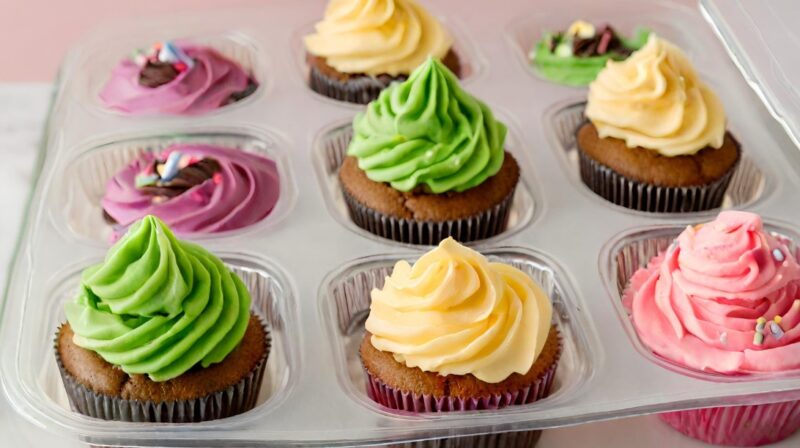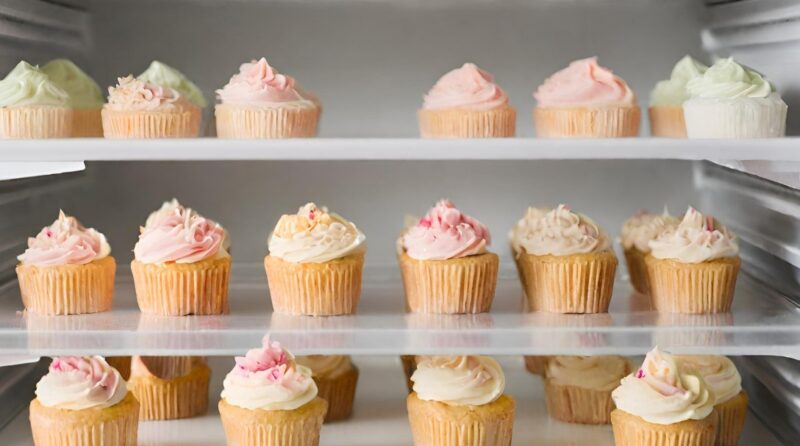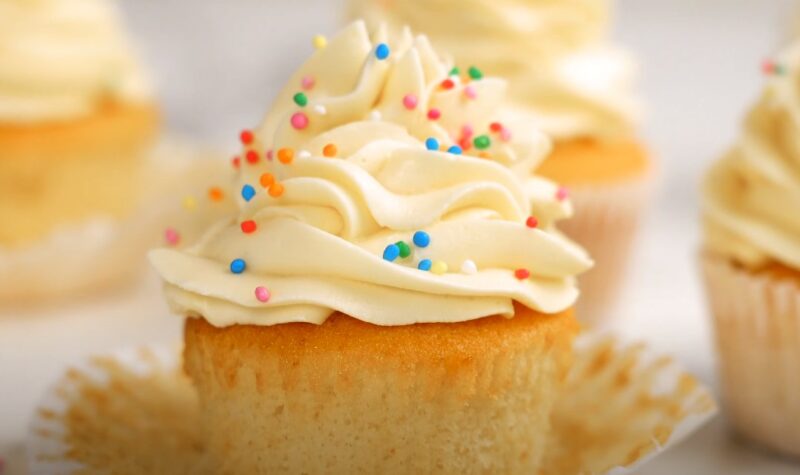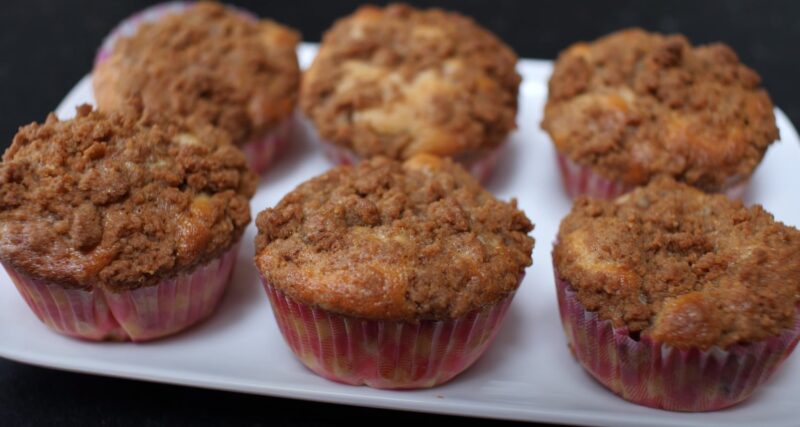As a lover of baking, I’ve often faced the challenge of keeping cupcakes fresh, especially after spending hours perfecting them. In this guide, I’ll share some practical tips that have helped me keep the muffins moist and delicious for days.
If you’re baking for a special occasion or just treating yourself, these simple strategies will ensure your cupcakes remain as irresistible as when they first came out of the oven.
Effective Storage Solutions
Short-Term Storage (Up to 48 Hours)
For short-term storage, up to about two days, the best practice is to keep cupcakes in an airtight container at room temperature. This method is effective in preventing air exposure, which can lead to drying out.
However, it’s important to be cautious with frosted muffins, as some types of frosting might require refrigeration to maintain their consistency and flavor, especially in warmer climates or during summer months.
Understanding the various factors that influence how long your cupcakes remain enjoyable, such as ingredient types and environmental conditions, can further enhance your storage strategies.
Long-Term Storage (Beyond 48 Hours)

When it comes to storing muffins for an extended period, beyond 48 hours, freezing is the most effective option. Unfrosted cupcakes can be individually wrapped in plastic wrap and then placed in an airtight container or freezer bag. This method can preserve their texture and taste for up to three months.
If you have frosted muffins, they can also be frozen, but it’s important to note that the texture of the frosting may change after thawing, especially for delicate frostings like whipped cream or meringue.
Special Considerations for Different Types of Frostings
Storing muffins with different types of frostings requires special consideration. Buttercream and ganache, for instance, are generally stable at room temperature for a couple of days. In contrast, cupcakes with cream cheese or whipped cream frosting should be refrigerated to prevent spoilage.
When refrigerating, it’s important to cover them well to prevent the frosting from absorbing any odors from other foods in the fridge.
Thawing and Serving

The process of thawing frozen cupcakes is critical to retain their quality. The best approach is to remove them from the freezer and let them gradually come to room temperature. This slow thawing process helps maintain moisture within the cupcake and prevents the formation of condensation, which can make the sponge soggy.
Refreshing Cupcakes Before Serving
Sometimes, even with the best storage methods, muffins might need a little refresh before serving. If they have lost a bit of their moisture, a few seconds in the microwave can do wonders for unfrosted cupcakes.
For frosted muffins, allowing them to sit at room temperature for a short period can help soften and improve the texture of the frosting.
Serving Tips for Optimal Freshness
When it comes time to serve your cupcakes, consider the environment and temperature. On warm days, it’s advisable to keep muffins in a cool place until it’s time to serve them to prevent the frosting from melting or becoming too soft.
Additionally, these should be served at a temperature that best accentuates their flavor and texture, which is usually at or just below room temperature.
Advanced Techniques for Maintaining Freshness

Utilizing Humidity Control
Humidity control is an advanced, yet often overlooked technique to keep muffins fresh. Storing a piece of bread or an apple slice in the same container can introduce just enough moisture to keep cupcakes soft without making them soggy.
It’s a delicate balance; too much moisture can lead to sogginess or even mold, while too little can result in dry muffins. Regularly checking and replacing the bread or apple slice ensures optimal moisture levels.
Importance of Ingredient Quality

The quality of ingredients not only affects the flavor of your muffins but also their shelf life. Using fresh, high-quality ingredients like premium flour, fresh eggs, and high-quality butter can significantly improve the moisture retention and overall freshness of the cupcakes.
These ingredients can make a notable difference in the texture, ensuring a moist crumb that lasts longer. Additionally, the purity of these ingredients means fewer additives, which can sometimes accelerate the staling process.
Innovative Packaging Solutions
Innovative packaging solutions can greatly enhance the freshness of your dessert. Cupcake domes or individual cupcake boxes provide excellent protection against air and moisture while maintaining the aesthetic appeal of your muffins.
These packaging options are particularly useful for transporting cupcakes or keeping them fresh for events or bake sales. They also help in maintaining the shape and integrity of the muffins, especially when they have delicate decorations or intricate frosting designs.
Common Mistakes to Avoid

Avoid Overbaking
Overbaking is one of the main culprits behind dry muffins. Cupcakes continue to cook slightly even after being removed from the oven, so it’s crucial to remove them just as they’re done. Using a toothpick to test for doneness is a reliable method; the toothpick should come out clean or with a few moist crumbs when inserted into the center of the cupcake.
Cool Them Properly Before Storage
A common mistake is storing cupcakes before they have completely cooled. This can trap steam inside the container, leading to moist tops and potentially soggy muffins. Always allow them to cool completely on a wire rack, which allows air to circulate around them, preventing condensation.
Frosting Considerations
Often, the type of frosting is overlooked when storing cupcakes. Muffins with frostings that contain perishable ingredients like cream cheese or whipped cream need to be refrigerated. However, refrigerating can sometimes dry out the cake parts, so it’s important to store them in an airtight container to minimize moisture loss.
Creative Ideas for Leftover Muffins

Creating Cupcake Trifles
Leftover cupcakes can be given a new lease of life by transforming them into delectable trifles. Layering crumbled muffins with whipped cream, fruit, and custard or pudding creates a delightful dessert that’s both visually appealing and delicious.
This approach is perfect for cupcakes that are slightly stale or have lost their initial softness, as the moisture from the cream and fruit helps rejuvenate them.
Cupcake Bread Pudding
Another creative way to use leftover cupcakes is to make a cupcake bread pudding. Simply chop the muffins into small pieces, mix them with a custard mixture made of eggs, milk, sugar, and your choice of flavorings, and bake until set.
This method not only repurposes the cupcakes but also creates a comforting, warm dessert that’s perfect for chilly evenings.
Using Crumbs for Decoration

Crumbling leftover cupcakes and using them as a topping for ice cream, yogurt, or even as a decorative element for other baked goods can add an extra dimension of flavor and texture.
Cupcake crumbs can provide a colorful and flavorful twist, especially if they are from vibrantly colored or uniquely flavored muffins. This technique is not only resourceful but also adds a gourmet touch to simple desserts.
FAQs
Can I use natural preservatives to prolong the freshness of my cupcakes?
Yes, natural preservatives like honey or lemon juice can be incorporated into cupcake recipes. Honey is a natural humectant, which helps retain moisture, while lemon juice, with its acidic properties, can extend shelf life. However, be mindful of how these ingredients might alter the flavor of your muffins.
How does the type of sugar used in cupcakes affect their freshness?
The type of sugar used can impact moisture retention in muffins. For instance, brown sugar, which contains molasses, can help cupcakes stay moist for longer compared to white sugar. Experimenting with sugar types can be a useful strategy for enhancing freshness.
Is it better to store cupcakes with or without frosting for longer freshness?
It’s generally better to store muffins without frosting if you’re looking to keep them fresh for a longer period. Frosting can sometimes introduce moisture to the top of the cupcake, which can affect texture.
Storing unfrosted cupcakes and applying frosting before serving is often the best approach.
Can altitude affect how long cupcakes stay fresh?
Yes, altitude can have an impact on cupcake freshness. Higher altitudes often mean lower air pressure and dryer air, which can cause muffins to dry out faster. In such environments, adjusting the recipe to increase moisture and choosing airtight storage containers are important considerations.
Are there specific types of cupcake pans that help retain freshness?
While the type of cupcake pan doesn’t directly affect freshness, heavy-duty pans that promote even baking can help prevent overbaking, which in turn can keep cupcakes moist for longer.
Silicone pans, for instance, provide even heat distribution and are known for their non-stick qualities, which can aid in retaining moisture.
How do I know if my stored cupcakes have gone bad?
Muffins that have gone bad will typically exhibit signs like a sour or off smell, mold growth, or a notably hard texture. If the cupcakes have an unusual appearance or smell, it’s best to discard them to avoid any risk of foodborne illness.
Always trust your senses when assessing the freshness of stored baked goods.
The Bottom Line
Choosing the right ingredients, and implementing effective storage methods, can significantly extend the deliciousness of your cupcakes.
Whether it’s experimenting with different sugars, choosing the right type of pan, or mastering the art of humidity control, each step contributes to ensuring your dessert remains as tantalizing as when it first came out of the oven.
The key to fresh muffins lies not only in how you bake them but also in how you store and care for them. Happy baking, and enjoy every sweet, fresh bite!
